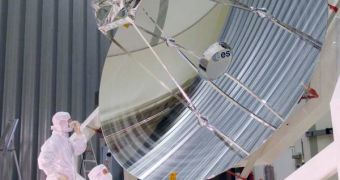The Herschel Space Telescope, which was launched on May 14th, has sent back its first set of flight data, but not through conventional channels, but via the use of mobile phone technology, the same type employed by GSM networks. The observatory, currently inbound to its Lagrangian (L) 2 orbital point, contacted ESA's deep space tracking station in New Norcia, Australia, and began a 1.5-Mbps test transmission, using the same amount of bandwidth as a regular home computer Internet connection.
The tracking center started receiving the transmission at 14:00 CEST (1200 GMT) on May 16th, less than two days after the picture-perfect launch that took place at the ESA-operated Kourou Space Center, in French Guyana, South America. Herschel blasted off to space along with the Planck telescope, both securely strapped aboard a heavy-lift Ariane 5 delivery vehicle.
Less than 48 hours after Herschel separated from its carrier, it switched its telemetry downlink to the “high rate mode” and began to transmit in the Gaussian Minimum Shift Keying (GMSK) modulation. This method of communication was selected over others because it had proven its efficiency on Earth, as far as bandwidth and power consumptions were concerned.
“Herschel’s 1.5-Mbps test transmission – roughly the same data rate provided by a home broadband Internet connection – was picked up at ESA’s ESTRACK station at New Norcia, Australia, on Saturday, as the satellite was traveling some 280 000 km from Earth,” the Herschel-Planck Flight Operations Director, John Dodsworth, shared. He and his mission control team are working at the agency's European Space Operations Center (ESOC), in Darmstadt, Germany.
The officials said that both new observatories would use GMSK extensively during their missions, either to send scientific data back to Earth, or to let engineers know their problems, and the overall status of their health.
One of the most terrific news about the new transmission is the fact that the parameters of the communication session were in tune with those obtained by mission planners in the countless simulations of the event they ran since the GMSK system was first envisioned on both observatories.
The decision to install such components on Herschel and Planck was driven by both the need for efficiency, and also by the desire to be more efficient. A growing number of ESA satellites already have, or will have GMSK communication systems, so the bandwidth the agency has available has to be as clean as possible.

 14 DAY TRIAL //
14 DAY TRIAL //